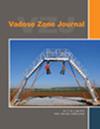Quantification of red soil macropores affected by slope erosion and sediment using computed tomography
IF 2.8
3区 地球科学
Q3 ENVIRONMENTAL SCIENCES
引用次数: 0
Abstract
Abstract Soil structure is an important factor interacting with soil erosion and sediment processes. However, few studies have focused on the relationship between soil macroporosity and soil erosion across different terrains. The aim of this study was to quantify and compare soil properties and macroporosity characteristics in collapsing gully areas and to explore their impact on the formation and development of collapsing gullies. Soil cores were excavated at different positions of a typical collapsing gully and then scanned to analyze soil macropores. Soil properties and saturated hydraulic conductivity were also investigated. The results showed that the contents of sand, silt, and clay, the mean weight diameter of aggregates, and the infiltrate rates varied at different positions. The valley had the greatest macroporosity (1.09% ± 0.33%), the number (5919 ± 703), volume (1468 ± 194 mm 3 ), and surface area (10.4 ± 2.6 m 2 ) of macropores, as well as the mean volume (16.8 ± 7.4 mm 3 ) of macropores >1 mm 3 , whereas these indices were lowest at the slope (0.15% ± 0.14%, 1189 ± 747, 266 ± 188 mm 3 , 1.7 ± 1.4 m 2 , and 10.6 ± 2.9 mm 3 , respectively). The macroporosity and the number of macropore decreased with increasing depth but were also influenced by the erosion and sediment processes. The processes of sediment and the roots of vegetation also influenced the orientation of the macropores. Macropore characteristics at different sites of the collapsing gullies affected the soil water infiltration and hydraulic conductivity and further affected the processes of water erosion and mass erosion.利用计算机断层成像技术定量分析坡面侵蚀和泥沙对红壤大孔隙的影响
摘要土壤结构是影响土壤侵蚀和泥沙过程的重要因素。然而,对不同地形土壤宏观孔隙度与土壤侵蚀的关系研究较少。本研究的目的是量化和比较崩塌沟壑区土壤性质和宏观孔隙特征,探讨其对崩塌沟壑区形成和发展的影响。在典型塌陷沟槽的不同位置开挖土芯,对土芯进行扫描分析。研究了土壤性质和饱和导水率。结果表明,不同位置的沙粒、粉粒和粘土含量、团聚体平均重径和渗透速率均存在差异。硅谷最大孔隙度(1.09%±0.33%),(5919±703)数量,体积(1468±194毫米3),和表面积大孔隙的(10.4±2.6米2),以及平均体积(16.8±7.4毫米3)大孔隙在1毫米3,而这些指数最低的斜率(0.15%±0.14%,1189±747、266±188毫米1.7±1.4米2和10.6±2.9毫米3,分别)。大孔隙率和大孔隙数随深度的增加而减少,但也受侵蚀和沉积过程的影响。沉积过程和植被根系对大孔的取向也有影响。崩塌沟槽不同部位的大孔特征影响了土壤的入渗和导水能力,进而影响了水侵蚀和物质侵蚀过程。
本文章由计算机程序翻译,如有差异,请以英文原文为准。
求助全文
约1分钟内获得全文
求助全文
来源期刊

Vadose Zone Journal
环境科学-环境科学
CiteScore
5.60
自引率
7.10%
发文量
61
审稿时长
3.8 months
期刊介绍:
Vadose Zone Journal is a unique publication outlet for interdisciplinary research and assessment of the vadose zone, the portion of the Critical Zone that comprises the Earth’s critical living surface down to groundwater. It is a peer-reviewed, international journal publishing reviews, original research, and special sections across a wide range of disciplines. Vadose Zone Journal reports fundamental and applied research from disciplinary and multidisciplinary investigations, including assessment and policy analyses, of the mostly unsaturated zone between the soil surface and the groundwater table. The goal is to disseminate information to facilitate science-based decision-making and sustainable management of the vadose zone. Examples of topic areas suitable for VZJ are variably saturated fluid flow, heat and solute transport in granular and fractured media, flow processes in the capillary fringe at or near the water table, water table management, regional and global climate change impacts on the vadose zone, carbon sequestration, design and performance of waste disposal facilities, long-term stewardship of contaminated sites in the vadose zone, biogeochemical transformation processes, microbial processes in shallow and deep formations, bioremediation, and the fate and transport of radionuclides, inorganic and organic chemicals, colloids, viruses, and microorganisms. Articles in VZJ also address yet-to-be-resolved issues, such as how to quantify heterogeneity of subsurface processes and properties, and how to couple physical, chemical, and biological processes across a range of spatial scales from the molecular to the global.
 求助内容:
求助内容: 应助结果提醒方式:
应助结果提醒方式:


